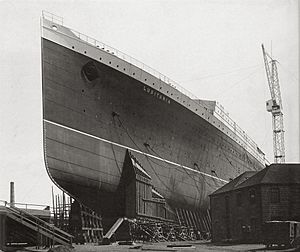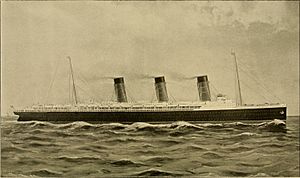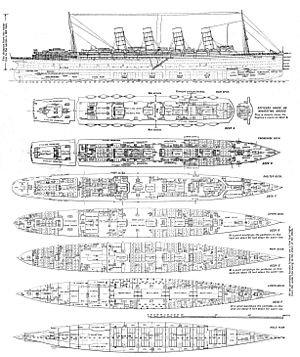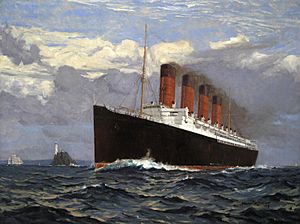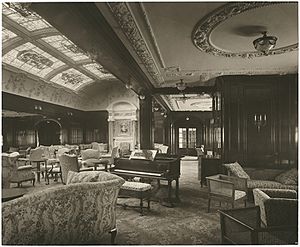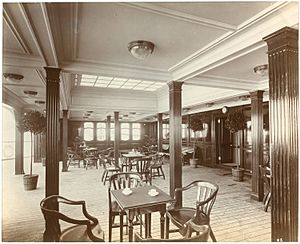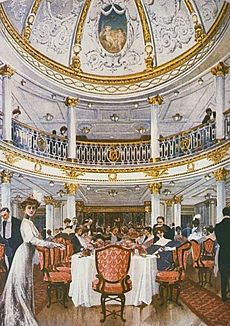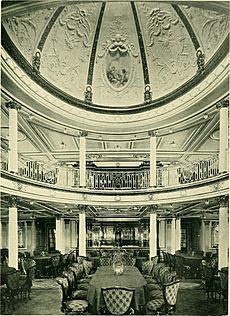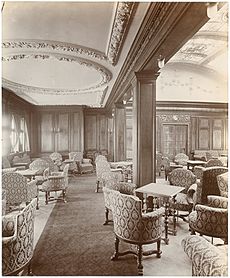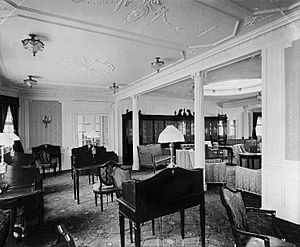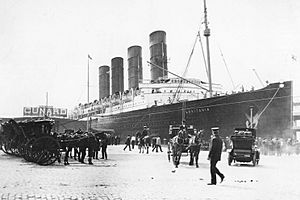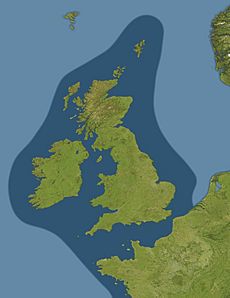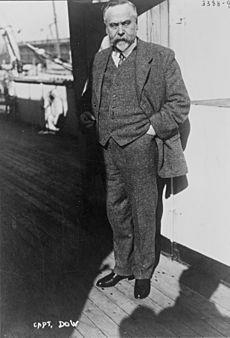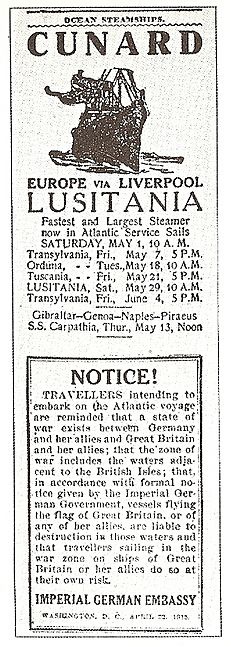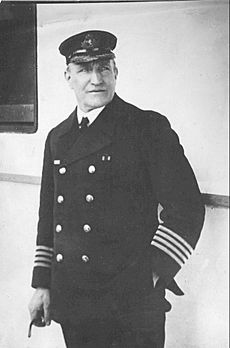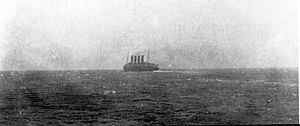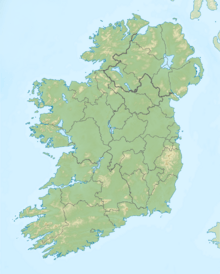RMS Lusitania facts for kids
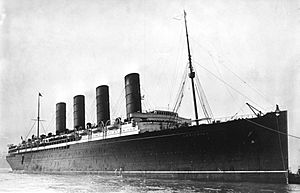
Lusitania arriving in New York City in 1907
|
|
Quick facts for kids History |
|
|---|---|
| Name | Lusitania |
| Namesake | Lusitania |
| Owner | Cunard Line |
| Operator | |
| Port of registry | Liverpool |
| Route | Liverpool to New York City via Cherbourg, France and Cork, Ireland |
| Builder | John Brown & Co, Clydebank, Scotland |
| Yard number | 367 |
| Laid down | 17 August 1904 |
| Launched | 7 June 1906 |
| Christened | Mary, Lady Inverclyde |
| Acquired | 26 August 1907 |
| Maiden voyage | 7 September 1907 |
| In service | 1907–1915 |
| Out of service | 7 May 1915 |
| Fate | Torpedoed by German U-boat U-20 and sank on Friday 7 May 1915. Wreck lies approximately 11 mi (18 km) off the Old Head of Kinsale Lighthouse in 305 ft (93 m) of water at 51°24′45″N 08°32′52″W / 51.41250°N 8.54778°W |
| Notes | Never survived the First World War. |
| General characteristics | |
| Type | Lusitania-Class Ocean liner |
| Tonnage | 31,550 GRT |
| Displacement | 44,060 long tons (44,767.0 t) |
| Length | 787 ft (239.9 m) |
| Beam | 87 ft (26.5 m) |
| Height | 65 ft (19.8 m) to boat deck, 165 ft (50.3 m) to aerials, 104 ft (31.7 m) from keel to top of boat deck, 144 ft (43.9 m) from keel to top of funnels |
| Draught | 33.6 ft (10.2 m) |
| Depth | 34 ft (10.4 m) |
| Decks | 9 passenger decks |
| Installed power | 25 Fire-tube boilers; four direct-acting Parsons steam turbines producing 76,000 hp (57 MW) |
| Propulsion | Four triple blade propellers. (Quadruple blade propellers installed in 1909.) |
| Capacity | 552 first class, 460 second class, 1,186 third class; 2,198 total. |
| Crew | 850 |
| Notes | First British four-funnelled ocean liner |
The RMS Lusitania was a famous ocean liner built for the Cunard Line. It was named after an ancient Roman province in Western Europe. Launched in 1906, she was known for being very fast. In 1908, she even held the record for the fastest trip across the Atlantic Ocean. For a short time, she was the biggest passenger ship in the world.
The Lusitania was tragically sunk on May 7, 1915, during her 202nd trip across the Atlantic. A German U-boat torpedoed her off the coast of Ireland. This event led to the deaths of 1,199 passengers and crew. The sinking happened about two years before the United States joined World War I. It played a big part in changing American public opinion against Germany.
German shipping companies were big rivals to Cunard in the early 1900s. To compete, Cunard built two new, very fast ships: the Lusitania and the Mauretania. The British government helped Cunard build these ships. In return, the ships could be used by the military if there was a war. They had special spots for cannons, but no guns were ever put on them. Both ships had powerful engines that let them travel very fast. They also had modern features like elevators, wireless radio, and electric lights. They offered much more space for passengers than other ships.
At the start of World War I, the British Navy blocked Germany's access to the sea. Germany responded by declaring the waters around the United Kingdom a war zone. German submarines became more active. When the Lusitania left New York on May 1, 1915, the German embassy in the United States put warnings in newspapers. These warnings told people about the dangers of sailing on the Lusitania.
On the afternoon of May 7, a German U-boat fired a torpedo at the Lusitania. This happened about 11 miles (18 km) off the southern coast of Ireland. A second explosion inside the ship caused it to sink in just 18 minutes. The German government said the Lusitania was a military target because it was carrying war supplies. They also argued that British merchant ships had not followed international rules for ships during wartime. However, the Lusitania was not armed for battle and had many civilian passengers. The sinking caused a huge protest in the United States because 128 American citizens died. This event helped turn public opinion in the U.S. against Germany.
Contents
Building the Lusitania
The Lusitania and Mauretania were ordered by Cunard to compete with German shipping companies. These German companies had bigger, faster, and more luxurious ships. They were also better at attracting people moving from Europe to North America.
An American businessman, J. P. Morgan, started a new company called International Mercantile Marine (IMM). IMM bought several British shipping companies. In 1902, IMM, along with German and Dutch companies, agreed to set prices and share the Atlantic shipping business. IMM tried to buy Cunard, which was now its main rival.
Cunard's chairman, Lord Inverclyde, asked the British government for help. The government agreed to lend Cunard money to build two new ships. These ships would be built to military standards. This meant they could be used as auxiliary cruisers in wartime.
Ship Design
Cunard formed a team to design the new ships. This team included experts in ship design and engine technology. They decided to use new steam turbine engines. These engines were powerful and created less vibration. They were also more reliable at high speeds.
The ship was designed by Leonard Peskett and built by John Brown and Company in Scotland. The name Lusitania came from an old Roman area. The ship was originally planned with three funnels. A fourth funnel was added later to handle the exhaust from more boilers. The ship was also designed with four propellers for more power.
The hull shape was tested to make sure the ship was stable. The ship's width was increased to improve its balance. The design also included features from naval ships to help it turn better. All the important machinery was placed below the waterline for protection. Coal bunkers were placed along the sides of the ship. This provided extra protection for the central parts of the ship.
The hull was divided into thirteen watertight sections. This meant that if two sections flooded, the ship would still float. However, a problem was that doors to the coal bunkers often had to be open. This made it hard to close them quickly in an emergency. The ship also had a double bottom with many watertight cells.
The Lusitania was built using strong steel. This made the ship lighter but still very strong. The ship had a system to heat and cool the air. It also had many fans to keep the air fresh. When built, the ship followed all safety rules. It had 16 lifeboats, enough for about 1,000 people.
When finished, the Lusitania was the largest ship ever built for a short time. It was soon surpassed by the Mauretania. The Lusitania was faster and carried more passengers than German liners. It could carry 552 first-class, 460 second-class, and 1,186 third-class passengers. The crew had 850 members. Both the Lusitania and Mauretania had wireless radio, electric lights, elevators, and beautiful interiors.
Inside the Ship
The Lusitania and Mauretania had some of the most luxurious interiors of their time. The Lusitania's interiors were designed by James Miller. He used plasterwork to create bright and open spaces.
The ship had six decks for passengers. These were the Boat Deck, Promenade Deck, Shelter Deck, Upper Deck, Main Deck, and Lower Deck. Each of the three passenger classes had their own areas. First, second, and third-class passengers were kept separate. The ship was designed to carry 2,198 passengers and 827 crew members.
First-class passengers stayed in the middle of the ship on the top five decks. The first-class dining room was very grand. It had two levels and a large dome decorated with paintings. The walls were made of carved mahogany. All other first-class public rooms were on the boat deck. These included a lounge, a reading and writing room, a smoking room, and a veranda café. The veranda café was new for a Cunard ship. One side could open up to make it feel like sitting outdoors.
The first-class lounge was decorated in a classic style. It had a vaulted skylight with stained glass windows. The library had carved walls and silk fabric. The smoking room had Italian wood panels. A grand staircase connected all six passenger decks. First-class cabins ranged from shared rooms to fancy suites with multiple rooms and bathrooms.
Second-class passengers stayed at the back of the ship. Their public rooms were in a separate section. The second-class dining room was smaller but still elegant. It had a dome and balcony like the first-class one. The smoking and ladies' rooms were also available. Second-class cabins were comfortable, with two or four beds.
Third-class accommodation on the Lusitania was much better than on other ships of the time. It was located at the front of the ship. Instead of large open dormitories, third-class passengers had cabins with two, four, six, or eight beds. The dining room was at the front of the ship and made of polished pine. There was also a smoking room and a ladies' room. A piano was provided for passengers to use.
Building and Testing
The Lusitania's construction began on August 17, 1904. It was built at John Brown & Company in Scotland. The shipyard had to be changed because the ship was so big. It was launched diagonally across the widest part of the River Clyde. The company spent a lot of money to prepare the shipyard.
The ship was launched on June 7, 1906. Thousands of people watched the event. After the launch, the ship was moved to a special area for fitting out. The ship's engines were tested in June 1907. During trials, the ship reached speeds of 25.6 knots (47.4 km/h; 29.5 mph). However, at high speeds, there was a lot of vibration at the back of the ship. This made the second-class areas uncomfortable. Workers added extra support to the ship's stern to fix this. The Lusitania was finally delivered to Cunard on August 26, 1907.
Comparing with the Olympic Class
The White Star Line built the Olympic-class class ships, which included the Olympic, Titanic, and Britannic. These ships were longer and wider than the Lusitania and Mauretania. This made them about 15,000 tons larger. The Lusitania and Mauretania were faster, but Cunard still needed a third ship for weekly service. So, they ordered the Aquitania. Like the Olympic, the Aquitania was slower but larger and more luxurious.
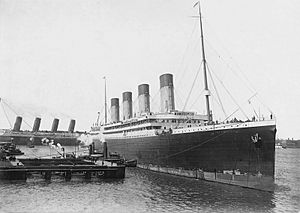
The Olympic class ships offered more features than the Lusitania and Mauretania. They had swimming pools, Turkish baths, gyms, and more private bathrooms. The Lusitania and Mauretania had strong vibrations from their engines, especially at top speed. This made parts of the ship uncomfortable. The Olympic class ships used a different engine system that caused less vibration. They were also more stable at sea. The Lusitania and Mauretania had straight bows. This meant they would cut through waves, causing large splashes over the front of the ship.
The Lusitania did not carry enough lifeboats for everyone on board when it first sailed. This was common for large ships then. People believed that in busy shipping lanes, help would always be nearby. After the Titanic sank, the Lusitania and Mauretania were given more lifeboats. They had 22 wooden boats and 26 collapsible lifeboats. However, the collapsible boats needed to be put together before use. This was different from the Olympic and Britannic, which had all their lifeboats ready to go. This difference contributed to the high number of deaths when the Lusitania sank. The ship listed so much that many lifeboats could not be launched.
Ship's Voyages
The Lusitania began her first voyage on September 7, 1907, from Liverpool. She was commanded by Commodore James Watt. At the time, she was the largest ocean liner in service. A huge crowd of 200,000 people watched her leave. She stopped at Queenstown to pick up more passengers.
She arrived in New York on September 13, 1907. The trip took 5 days and 54 minutes. Fog had delayed the ship. In New York, hundreds of thousands of people gathered to see her. The ship was open for tours during her week-long stay.
On her second trip, the Lusitania set a new record. She arrived in New York on October 11, 1907, in 4 days, 19 hours, and 53 minutes. This earned her the Blue Riband award for the fastest Atlantic crossing. In December 1907, the Mauretania took the record for the fastest eastbound crossing. The Lusitania briefly got the record back in July 1909. But the Mauretania quickly recaptured it and held it until 1929. During her eight years of service, the Lusitania made 201 trips. She carried over 155,000 passengers going west and over 106,000 going east.
Hudson Fulton Celebration
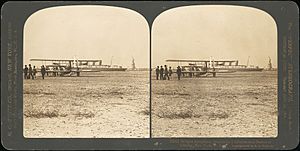
In 1909, the Lusitania took part in the Hudson-Fulton Celebration in New York City. This event showed off different types of transportation. The Lusitania represented the latest in steamship technology. At the same time, Wilbur Wright flew his Flyer airplane over the city. Some of his flights were directly over the Lusitania. This showed how quickly new ways of travel were developing.
Rogue Wave Encounter
On January 10, 1910, the Lusitania was sailing from Liverpool to New York. Two days into the trip, she hit a huge rogue wave that was about 75 feet (23 m) high. The wave crashed over the bow and hit the bridge. The bridge windows were smashed, and the deck was damaged. No one was hurt, and the ship continued its journey. However, it arrived a few hours late in New York.
World War I and the Lusitania
When the Lusitania was built, the British government helped pay for it. This was because it could be used as an armed merchant cruiser (AMC) if needed. It even had a secret area for carrying weapons. When World War I started, the British military officially listed her as an AMC.
At the start of the war, people worried about the safety of large ships like the Lusitania. For her first trip after the war began, she was painted grey. This was to make her harder to spot. Many large ships were stopped from sailing during the war. Some became troop transports or hospital ships. But the Lusitania kept sailing for passengers. To save money, one of her boiler rooms was shut down. This reduced her top speed. Her grey paint was also removed, and she returned to her normal civilian colors.
1915: The Final Voyage
In early 1915, German submarines became a new threat. At first, they attacked only military ships. But then, Germany declared the seas around Britain and Ireland a war zone. From February 18, Allied ships in this area could be sunk without warning.
The Lusitania was given special instructions on how to avoid submarines. Captain Dow, who was in command, was replaced by Captain William Thomas Turner. Captain Turner had commanded the Lusitania before the war.
On April 17, 1915, the Lusitania left Liverpool for New York. Before her return trip, the German Embassy in the United States placed a warning in 50 American newspapers. It told travelers that a state of war existed and that ships flying the British flag were at risk. This warning was printed right next to an advertisement for the Lusitania's voyage. Many people saw this as a direct warning about the ship.
The ship left New York on May 1, 1915, on what would be her last journey.
The Sinking
On May 7, 1915, the Lusitania was almost at the end of her trip. She was heading for Liverpool. There were 1,266 passengers and 696 crew members on board, totaling 1,962 people. She was sailing parallel to the south coast of Ireland. At about 2:10 p.m., she crossed paths with the German U-boat U-20.
The U-boat's commander, Walther Schwieger, ordered one torpedo to be fired. It hit the Lusitania on the right side, near the front. Moments later, a second explosion happened inside the ship. The ship began to sink very quickly, tilting heavily to the right.
The crew tried to launch the lifeboats, but it was very difficult. The ship was tilting so much that many lifeboats could not be used. Only 6 out of 48 lifeboats were successfully launched. Many others overturned or broke apart. Eighteen minutes after the torpedo hit, the ship went under the water. The funnels and masts were the last parts to disappear.
Out of the 1,962 people on board, 1,199 lost their lives. After the sinking, brave survivors and Irish rescuers helped save people. The total number of survivors was 764. News of the disaster quickly spread around the world. Many of those who died were British or Canadian. The loss of 128 American citizens caused great anger in the United States.
After the Sinking
The sinking of the Lusitania caused a huge international outcry. This was especially true in Britain and the United States. A German spokesman, Bernhard Dernburg, said that Germany had a right to sink the ship. He claimed the Lusitania was carrying war supplies and was listed as a military ship. He also said that Germany had warned passengers before the ship sailed.
The Lusitania was indeed listed as a military support ship. While not armed with guns, its cargo included millions of rifle cartridges and other military items. This information was listed in her cargo manifest. The assistant manager of the Cunard Line admitted the ship carried small-arms ammunition. The British public was not told about this at the time.
In the United States, public opinion was furious. Many people wanted to go to war. President Woodrow Wilson did not declare war right away. He wanted to try and negotiate an end to the war. The U.S. and German governments exchanged messages about the sinking. Germany continued to argue that the Lusitania was a valid military target. They said it was listed as an armed ship and had orders to try and ram submarines.
President Wilson kept asking Germany to apologize, pay money to the American victims, and promise not to do it again. The British were disappointed that Wilson did not take stronger action. The U.S. Secretary of State, William Jennings Bryan, resigned. He felt that the U.S. was being unfair and leading the country into war.
In January 1917, Germany announced it would again use full unrestricted submarine warfare. This, along with another event called the Zimmermann Telegram, pushed American public opinion over the edge. On April 6, 1917, the United States declared war on Germany.
In 2014, some old papers were released. They showed that in 1982, the British government warned divers that there might be explosives on board the Lusitania. A diplomat wrote that there was "a large amount of ammunition in the wreck, some of which is highly dangerous." However, a later inquiry found no proof of secret munitions. It was known that the ship carried about 5,000 cases of small arms ammunition. No explosives were found by the salvage company.
100th Anniversary
On May 3, 2015, a group of boats sailed from the Isle of Man. This was to remember the 100th anniversary of the sinking. Seven fishermen from the Isle of Man had rescued 150 people from the sinking ship.
On May 7, 2015, the 100th anniversary of the sinking was marked. Cunard's MS Queen Victoria sailed to Cork, Ireland, for the occasion.
The Wreck
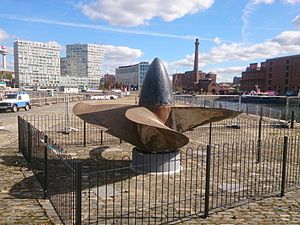
The wreck of the Lusitania was found on October 6, 1935. It lies about 11 miles (18 km) south of the Kinsale lighthouse. The ship rests on its right side, tilted at about 30 degrees, in about 305 feet (93 m) of water. The wreck is badly damaged. This is because of how hard it hit the bottom, winter storms, and rust over the years.
The front part of the ship is the most visible. The back part is damaged from depth charges. Three of the four propellers were removed in 1982 for display. The Lusitania wreck has decayed much faster than the Titanic wreck. This is because it is in shallower water. Fishing nets, depth charges, and salvage operations have also caused damage. The wreck is not stable and might collapse completely one day.
Salvage Efforts
Between 1931 and 1935, an American inventor named Simon Lake tried to salvage the Lusitania. He planned to use a special steel tube to reach the wreck. His main goal was to find the ship's safe and historical items. However, his company had financial problems, and the plan did not happen.
In 1935, a Scottish team found the wreck. A diver named Jim Jarrett explored the wreck using a special diving suit.
In 1967, the wreck was sold to a former US Navy diver, John Light. Gregg Bemis became a co-owner in 1968 and later bought out his partners. He went to court to make sure his ownership was legal. In 1995, the Irish Government declared the wreck a heritage site. This meant no one could disturb it. After a long legal fight, Bemis was given a license in 2007 to explore the wreck. He wanted to find artifacts and evidence to understand what happened. He planned to give any items found to museums.
In 2008, Bemis was allowed to photograph and film the wreck. He hired a company to do this. A dive team found 15,000 rounds of rifle ammunition in the ship's bow. They photographed it but left it there. In 2016, a salvage dive recovered a telegraph machine but then lost it. This caused controversy because the dive was not supervised by experts.
A TV show called Sinking of the Lusitania: Terror at Sea came out in 2007. In 2018, Gregg Bemis talked on the radio about the Lusitania. He shared new information, including that many depth charges were found at the wreck site.
Diving Dangers
Diving to the Lusitania wreck is very dangerous. Divers need to use special gas mixtures. The wreck is covered in fishing nets and may have old depth charges and mines. Visibility is also very poor due to sediment.
1984 British Legal Action
In 1982, some items were recovered from the wreck and brought to the United Kingdom. There was a legal case about who owned these items. The judge decided that the British government did not own wrecks outside British waters. This case is still important in law today.
Cultural Impact
See also
 In Spanish: RMS Lusitania para niños
In Spanish: RMS Lusitania para niños
- Avis Dolphin, a survivor
- Ian Holbourn, a survivor
- Rita Jolivet, a survivor
- Charles T. Jeffery, a survivor
- Theodate Pope Riddle, a survivor
- List of ships sunk by submarines by death toll
- The Carpet from Bagdad, a mostly lost 1915 film, one reel was recovered from the wreck in 1982


